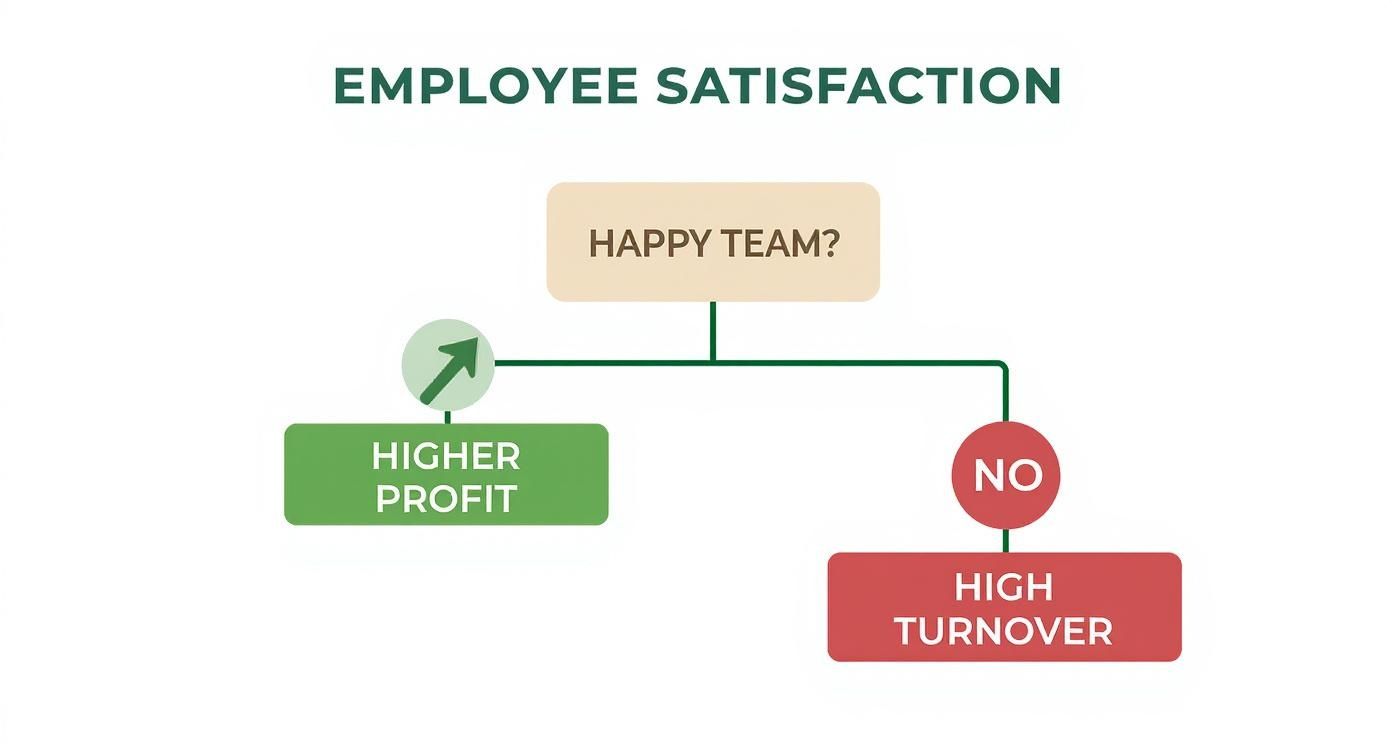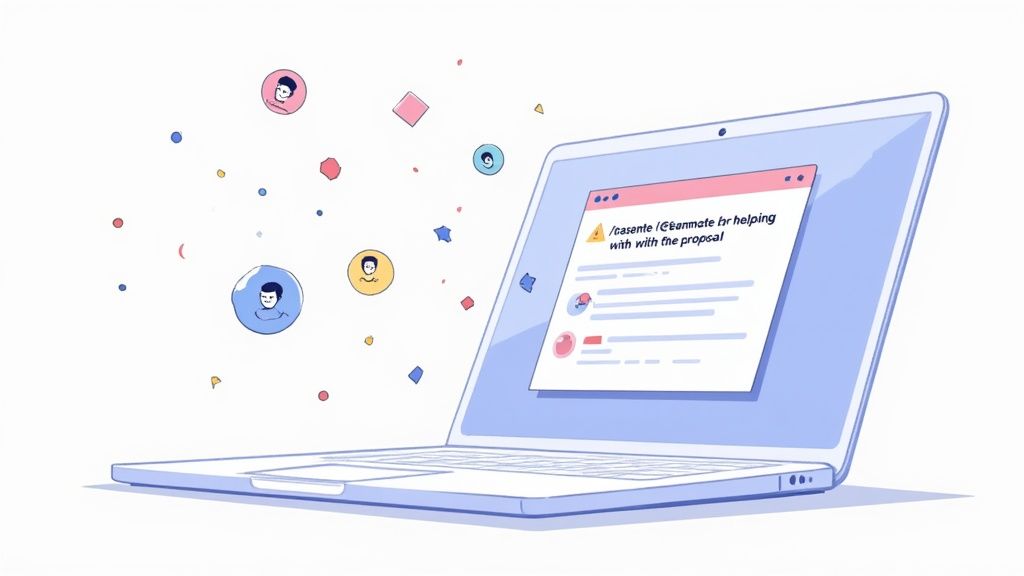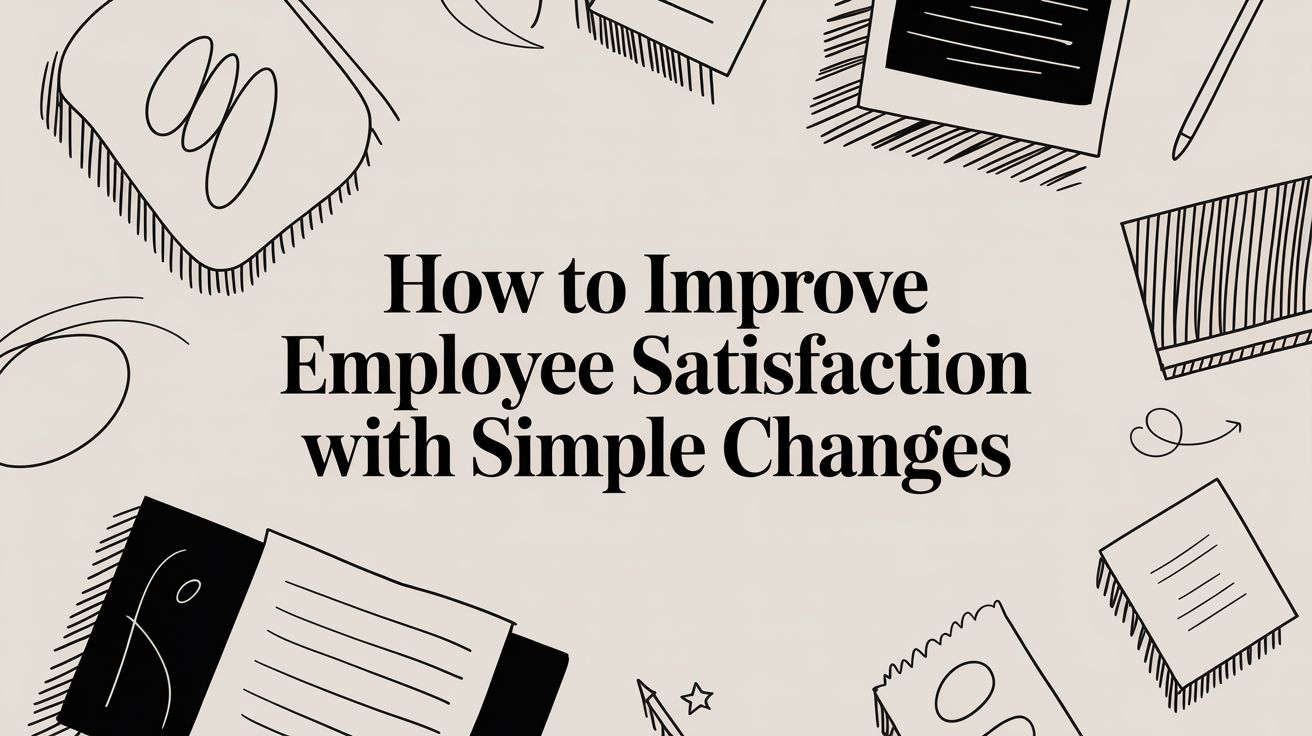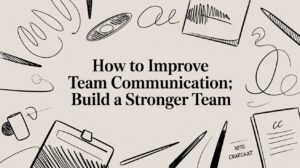Let’s be honest, trying to improve employee satisfaction by simply throwing perks at people is like putting a band-aid on a broken leg. The real fix lies in focusing on what actually drives your team day-to-day: meaningful work, consistent recognition, and a genuinely supportive culture.
Table of Contents
When you get these fundamentals right, you’re not just improving morale; you’re building a foundation for better productivity, higher retention, and a healthier bottom line.
Why Employee Satisfaction Is a Business Imperative
Employee satisfaction isn’t some fluffy, feel-good metric. It’s a hard-hitting business imperative. There’s a straight, measurable line connecting a happy, engaged team to a successful company.
When your people feel valued and see a clear purpose in their work, the positive impact is felt throughout the organization. We’re not just talking about creating a pleasant office vibe; we’re talking about building a rock-solid competitive advantage.
A huge mistake I see companies make is thinking satisfaction is all about the paycheck. While fair compensation is table stakes, study after study shows it’s rarely the main reason people love—or leave—their jobs.
The Real Drivers of a Happy Team
So, what really moves the needle? It’s a mix of things that make work feel worthwhile. People want to know their effort matters, their growth is a priority, and they belong to a team that has their back.
It really boils down to these core elements:
- Meaningful Work: Can your team members connect their daily tasks to the bigger company mission? They need to see the “why” behind their work.
- Consistent Recognition: Regular, specific praise for a job well done is incredibly powerful. It reinforces great work and makes people feel seen.
- Supportive Culture: This is everything from feeling safe to speak up and having a real work-life balance to trusting your manager and enjoying your colleagues.
The High Cost of Neglecting Satisfaction
Let these areas slide, and you’ll feel the pain. Disengaged employees aren’t just checked out; they’re often on their way out the door.
Gallup’s research is pretty clear on this: highly engaged teams are 23% more profitable and experience up to a 43% lower turnover rate. High turnover isn’t just a recruiting headache; it’s a massive drain of institutional knowledge, a killer of team momentum, and a direct hit to your budget.
Investing in employee satisfaction isn’t an expense; it’s one of the smartest investments you can make. It turns your company culture from a potential weakness into your greatest asset.
Think of this guide as your playbook for getting to the root of low morale. We’ll walk through practical, strategic changes—like setting up a simple peer recognition program—that can genuinely transform your workplace in ways your team will actually feel.
Uncovering the Real Reasons for Team Dissatisfaction
Before you can fix low employee satisfaction, you have to play detective. It’s all too easy to make assumptions about why morale is down—maybe you point to heavy workloads or a recent pivot in the company’s direction. But jumping to conclusions often leads to “solutions” that completely miss the mark. The real work is getting past the surface-level complaints to find the genuine root causes of your team’s frustration.
This whole process hinges on creating an environment of psychological safety. Your team needs to feel secure enough to give you the unvarnished truth without fearing it’ll come back to bite them. When people trust that their voice actually matters, you get the candid insights needed to make changes that count.
Gathering Honest and Actionable Feedback
Once you’ve set the stage for open dialogue, you need the right tools to really listen. Relying on casual chats by the coffee machine won’t give you the full picture; you’ll just hear from the loudest voices. A more structured approach helps you capture consistent data from everyone, making it easier to spot trends instead of just reacting to one-off issues.
Here are a few methods I’ve seen work wonders:
- Anonymous Pulse Surveys: Think of these as a regular health check for your team. They’re short, frequent, and—most importantly—anonymous. This encourages people to be brutally honest about sensitive topics they might not bring up otherwise.
- Structured One-on-Ones: This dedicated time between a manager and their direct report is pure gold, but only if it’s done right. The meeting should be about the employee’s world—their challenges, their goals, their feedback—not just another project status update.
- Small Group “Stay” Interviews: Why wait for exit interviews to find out why people leave? I’m a huge advocate for “stay” interviews, where you ask people why they stay. Questions like, “What got you excited to come to work this week?” can tell you exactly what you’re doing right and need to double down on.
The feedback method you choose can drastically change the quality of the information you receive. It’s not a one-size-fits-all situation; different scenarios call for different tools.
Choosing Your Employee Feedback Method
| Method | Pros | Cons | Best For |
|---|---|---|---|
| Anonymous Pulse Surveys | High honesty rates; easy to spot trends over time; quick for employees to complete. | Lacks context; can’t ask follow-up questions to specific individuals. | Getting a quick, regular snapshot of overall team sentiment and tracking morale changes. |
| Structured One-on-Ones | Builds trust; allows for deep, contextual conversations; great for personalized problem-solving. | Can be time-consuming; relies on the manager’s skill to create a safe space. | Addressing individual concerns, career development discussions, and building strong relationships. |
| “Stay” Interviews | Proactive and positive; highlights what’s working well; boosts engagement by showing you value them. | Might not uncover deep-seated negative issues if employees are hesitant to be critical. | Identifying and reinforcing the key drivers of retention and positive company culture. |
| Group Feedback Sessions | Encourages collaborative problem-solving; can generate diverse ideas quickly. | Risk of groupthink; quieter employees may not speak up; can devolve without a skilled facilitator. | Brainstorming solutions to a known issue or gathering input on a specific new initiative. |
Ultimately, a mix of these methods usually gives the most complete picture. Use surveys to identify the “what” and one-on-ones or group sessions to understand the “why.”
This decision tree visualizes the direct link between a satisfied team and positive business outcomes, showing that a happy team leads to higher profits while dissatisfaction results in costly turnover.

The visualization drives home a critical point: investing in your team’s well-being isn’t a fluffy “nice-to-have”—it’s a direct driver of your bottom line.
Differentiating Symptoms from Root Causes
Getting the feedback is step one. The real magic happens when you start interpreting it. It’s so important to distinguish between the symptoms your team is reporting and the underlying problems causing them. A classic mistake is to put a bandage on the symptom without ever diagnosing the illness.
Let me give you a real-world example. A marketing team constantly says they feel overworked and burned out. The symptom is clear: burnout. A manager might react by telling everyone to take more PTO or rushing to hire another person.
But you have to dig deeper. Is the team actually overworked because of a headcount issue, or is something else going on? In many cases, things like inefficient project management, constantly shifting priorities, or a flood of last-minute requests from leadership are the real culprits. These issues create the feeling of an impossible workload, even if the total volume of work is manageable.
The root cause isn’t the work itself, but the chaos surrounding it. Fix the broken process, and you’ll do more to reduce stress than adding another person to the team ever could.
To get to that level of insight, you need to ask good follow-up questions. When an employee says, “I have way too much on my plate,” don’t just nod and agree. Ask things like:
- “Can you walk me through what a typical day looks like for you?”
- “Which tasks seem to be taking up the most unexpected time?”
- “Where are you seeing the biggest bottlenecks in your workflow?”
These questions turn a complaint into a collaborative problem-solving session. By meticulously digging into the feedback and refusing to take symptoms at face value, you build a data-backed picture of what’s really happening. That accurate diagnosis is the only way you can start implementing solutions that will genuinely move the needle on employee satisfaction.
Weaving Recognition into Your Company’s DNA
If you’re hunting for a single, low-cost strategy that delivers an outsized impact on employee satisfaction, this is it. Building a culture of meaningful recognition isn’t about some grand, complicated program. It’s about making appreciation a daily habit—frequent, specific, and genuine. It’s the most powerful way to show your team that their work is seen, understood, and valued.
Team recognition is critical because it reinforces the behaviors you want to see repeated. When you celebrate someone for collaborating effectively or taking initiative, you’re not just making that one person feel good; you’re sending a clear signal to the entire company about what success looks like. This public acknowledgment acts as a powerful guidepost, shaping your culture and motivating others to emulate those valued actions.
When people feel their contributions actually matter, they are more than twice as likely to be engaged. This isn’t about tossing around generic “good job” comments. It’s about connecting what someone did to the team’s larger purpose.

What Great Recognition Actually Looks Like
So, what separates a powerful shout-out from an empty compliment that just fades away? The best recognition is specific and, crucially, highlights the impact of someone’s work. It goes beyond acknowledging the task and answers the question, “Why did this matter?”
Let’s look at the difference with a practical example:
- Generic Praise: “Thanks for fixing that bug, Sarah. Good job.”
- Impactful Praise: “Sarah, thank you for digging into that complex bug on the checkout page. Your persistence didn’t just fix the issue; it reinforced our company value of customer obsession. Because of your work, we avoided a potential drop in sales this weekend.”
The second example is exponentially more powerful. It tells Sarah her effort was noticed, explains the tangible business impact, and ties her actions directly to a core company value. This is how you make an employee feel indispensable.
It’s Not Just a Manager’s Job
While praise from a manager is vital, a truly vibrant culture of appreciation empowers everyone to participate. That’s where peer-to-peer recognition comes in, and frankly, it’s a game-changer. It multiplies the sources of positive feedback and strengthens the bonds that hold a team together.
Think about it: colleagues often have the clearest view of the day-to-day efforts that a manager might miss. When you encourage them to celebrate each other, you’re building a supportive, collaborative environment where everyone feels responsible for lifting each other up.
A simple shout-out from a peer can make a huge difference. Imagine an account manager publicly thanking a support specialist for their quick help on a tricky client ticket. That simple act reinforces the value of cross-functional teamwork and builds trust in a way that top-down recognition alone never could.
A sobering study from Gallup found that only one in three U.S. workers strongly agree they received recognition for good work in the past week. This isn’t just a statistic; it’s a massive opportunity to stand out.
Practical Ways to Make Recognition a Habit
You don’t need a huge budget to make recognition a cornerstone of your culture. The real key is consistency. By creating simple rituals and easy-to-use channels, you turn a one-off action into a cultural norm.
Here are a few practical examples to get started:
- Launch a dedicated Slack channel. Create a public space like
#kudosor#shoutoutswhere anyone can post praise. This makes recognition visible and encourages a ripple effect. - Kick off meetings with “wins.” Dedicate the first five minutes of a weekly team meeting for people to share wins and recognize colleagues who helped them. This ritualizes appreciation.
- Never underestimate a personal note. A handwritten thank-you from a leader can have a profound impact. It shows a level of personal care and effort that a quick email just can’t match.
These methods work because they’re simple, visible, and can slide right into your team’s existing workflow without creating friction.
Why Variety in Recognition Matters
Just like people have different ways of communicating, they also have different preferences for receiving praise. Some people love a public shout-out, while others might feel awkward in the spotlight and prefer a quiet, private acknowledgment.
A well-rounded program offers a mix of public and private options to make sure everyone feels seen. It shows you respect individual personalities and are committed to making everyone feel appreciated in a way that resonates with them personally.
Here’s a quick breakdown of different types and when they work best:
| Recognition Type | Best For | Practical Example |
|---|---|---|
| Public Social Recognition | Celebrating big wins, reinforcing team values, and encouraging collaboration. | A company-wide email or Slack post celebrating the project team that launched a new feature. |
| Private Manager Recognition | Providing specific, developmental feedback or acknowledging a personal milestone. | A direct message from a manager praising an employee’s masterful handling of a difficult client call. |
| Peer-to-Peer Recognition | Highlighting day-to-day helpfulness and building team camaraderie. | Using a tool like AsanteBot for a quick “thank you” emoji and points in Slack. |
| Tangible Rewards | Marking significant achievements or sustained high performance. | Offering a gift card, an extra day off, or a team lunch after nailing a major project. |
Ultimately, the goal is to create a multi-layered system where every positive contribution, big or small, has a chance to be seen and celebrated. By embedding frequent, specific, and varied recognition into your company’s DNA, you build a resilient, motivated, and deeply satisfied team that knows their hard work truly matters.
Designing Programs That Genuinely Support Your Team
Let’s be honest: employee satisfaction isn’t built on free pizza or the occasional happy hour. Those things are nice, but they’re temporary fixes. Real, lasting satisfaction comes from structured, thoughtful programs that show you’re invested in your team as people, not just cogs in a machine.
These systems are your blueprint for demonstrating genuine support. When you get them right, you’re sending a powerful message: we see you, we hear you, and we’re committed to building an environment where you can actually thrive. This is how you move the needle on satisfaction in a way that truly sticks.
Fostering a Healthy Work-Life Balance
The conversation around work-life balance has completely changed. It’s no longer enough to just say you support it; your people need to see real policies that protect their time and mental well-being. Without firm boundaries, the lines between work and home get fuzzy, and that’s a fast track to burnout.
A great first step is establishing clear rules for after-hours communication. As a practical example, a company could roll out a policy that non-urgent emails or messages sent after 6 PM don’t need a response until the next business day. This simple guideline gives your team explicit permission to disconnect and recharge—something many people struggle to do on their own.
Another powerful tactic is implementing “focus time” blocks across the company. Here are some practical ways to do it:
- No-Meeting Wednesdays: Try dedicating one full day, or even just a morning, to be completely free of internal meetings. It’s amazing what your team can accomplish with a solid block of uninterrupted time for deep work.
- Color-Coded Calendars: Encourage everyone to block off and color-code “focus time” on their shared calendars. This serves as a clear, visual signal to colleagues that they’re unavailable for quick questions or ad-hoc chats.
These aren’t just fluffy perks; they are structural changes that show you respect an employee’s most valuable resource: their time.
Investing in Professional Growth and Purpose
For most people today, a job is far more than just a paycheck—it’s a critical step on their career path. Employees, especially younger generations, are actively looking for roles where they can sharpen their skills and feel connected to a bigger mission. Investing in their development is one of the most direct ways to show you’re invested in them.
Research from Deloitte drives this point home, finding that roughly nine in ten Gen Zs (89%) and millennials (92%) see a sense of purpose as crucial to their job satisfaction. This isn’t a small thing; it’s a primary driver for why people stay or go, often weighing more heavily than salary. You can discover more insights about what motivates the modern workforce in Deloitte’s full survey.
Building transparent career paths is non-negotiable. Your team should be able to see exactly what skills and milestones they need to hit to reach the next level. When the path forward is a mystery, motivation plummets.
Beyond just showing them the path, you have to put your money where your mouth is. A practical example is offering a dedicated budget for learning and development that employees can use for courses, conferences, or certifications. This proves you’re not just expecting them to grow on their own; you’re actively funding their journey. As you design these programs, think about using tools like video personalization software to create unique and impactful training or recognition messages that really connect with people.
Training Managers to Be Effective Coaches
A manager is the single most important person in an employee’s day-to-day work life. Someone can love the company’s mission, but if their direct manager is a poor leader, their satisfaction will tank. That’s why training your managers to be effective coaches—not just taskmasters—is an absolute game-changer.
A coach-like manager does things differently. They focus on:
- Asking, not telling: They guide team members to discover their own solutions, fostering independence and critical thinking.
- Focusing on strengths: They’re experts at identifying what each person does best and helping them lean into those talents.
- Connecting work to goals: They help people see the throughline between their daily tasks and their long-term career aspirations.
This approach doesn’t happen by accident. It requires specific training in active listening, delivering constructive feedback, and understanding what truly motivates each person. By investing in your managers’ coaching skills, you create a ripple effect of support and empowerment that reaches every single person on their team. For more ways managers can build these connections, check out our guide on actionable employee appreciation ideas.
Ultimately, it’s these programmatic changes—protecting personal time, funding professional growth, and developing coach-like managers—that create a workplace people don’t want to leave. They’re the tangible proof that you value your team’s well-being and their future, transforming employee satisfaction from a fleeting feeling into a core part of your culture.
Weaving Daily Recognition into Slack
So, how do you get recognition to be a daily habit instead of a once-a-quarter formal affair? You meet your team where they already are. For most of us, that’s Slack. The key is to turn this everyday communication tool into a genuine hub for appreciation, making it second nature to give and receive praise.
When a quick “thank you” can be shared in the same place as project updates, it just happens more often. That simple shift is one of the most powerful, organic ways I’ve seen to boost employee satisfaction. It stops being a task and starts being part of the conversation.
Create Your Company’s Recognition Hub
First things first, you need a dedicated public channel. I’ve seen #shoutouts, #kudos, and #wins all work beautifully. The name isn’t as important as its purpose: to be a single, visible place for celebrating each other.
Why public? Because visibility is everything. It accomplishes two critical things:
- The person being recognized feels seen and valued not just by one person, but by their peers and leaders across the company.
- It subtly teaches everyone else what great work looks like and encourages them to join in.
This dedicated space ensures praise doesn’t get buried in a dozen different project channels. It gives celebration a home.
When you make recognition public, you’re not just celebrating a person—you’re reinforcing the very behaviors and values you want to see repeated. A shoutout for someone’s killer collaboration on a tough project tells the whole company, “This is what we value here.”
Once you’ve got the channel, build a simple ritual around it. One of my favorite practical examples is a “Friday Wins” prompt. A team lead just pops in and asks everyone to share a success from the week and tag a colleague who helped them get there. It’s a small nudge that builds a powerful weekly habit of gratitude.
Here’s a perfect example of how an app like AsanteBot can make this flow seamlessly right within Slack.

As you can see, a simple command creates a great-looking public shout-out, complete with emojis and points. It makes appreciation both fun and impossible to miss.
Use Smart Tools to Scale Appreciation
A dedicated channel is a fantastic starting point, but as your company grows, you’ll need something more robust to keep the momentum going. This is where tools built for Slack recognition, like AsanteBot, really shine. They help you move from a manual effort to a system that pretty much runs itself.
Think about it. An employee can just type /asante @teammate for jumping in on that client proposal. In an instant, that message is posted in the #shoutouts channel, perfectly formatted for everyone to see. It takes all the friction out of the process. If you want to dive deeper into how visual cues can boost a message’s impact, check out our guide on using emojis for Slack.
These tools also bring a bit of fun and friendly competition into the mix. With features like points, leaderboards, and custom rewards, you’re not just tracking praise—you’re gamifying it. An employee might notice they’re just a few points away from a coffee gift card, giving them that extra nudge to recognize a coworker who went above and beyond that week. It turns recognition from something passive into an engaging, motivating part of your culture.
Turning Your Team’s Satisfaction Around for Good
Boosting employee satisfaction isn’t a one-and-done project. It’s an ongoing commitment, a fundamental shift in how you operate and care for your people. It all starts with getting to the heart of what your team is really feeling, whether you uncover that through candid conversations or well-designed surveys.
Once you have that baseline, you can start building a culture where meaningful recognition is a daily habit, not just a yearly bonus. This is where the real magic happens.
That foundation gets stronger when you add in structured programs that support genuine growth and work-life balance, and you cement it all with tools that make saying “thank you” feel natural and easy. To tie it all together, you have to actively create a positive work environment, which is the glue that holds all these pieces together.
The secret? Start small, but be ridiculously consistent. Don’t try to boil the ocean. Just focus on one thing, like introducing a new recognition ritual this week or asking better questions in your next one-on-one.
This iterative approach is how you build real momentum. When you consistently invest in your team’s happiness, you’re not just checking a box—you’re making the single smartest investment in your company’s future success and its ability to weather any storm.
Common Questions About Improving Employee Satisfaction
As you start digging into employee satisfaction, you’ll inevitably hit a few common questions. It’s normal to feel a bit unsure when you’re just starting out, but getting clear on these points will help you move forward with confidence. Let’s tackle some of the most frequent ones I hear from managers.
How Do I Actually Measure the ROI of This Stuff?
This is the big one. To get real, long-term buy-in for any satisfaction initiative, you have to prove its worth. The key is to connect your efforts to hard business metrics. We’re not just tracking good vibes; we’re measuring real impact.
The best way to do this is to get a baseline of your key performance indicators before you launch anything new. Then, keep a close eye on them as your programs roll out.
- Employee Turnover: A drop in voluntary turnover is your most direct win. You can even put a dollar figure on it by calculating the cost to replace an employee—think recruitment fees, training time, and lost productivity. That number gets people’s attention.
- Absenteeism: Happier, more engaged people take fewer sick days. If you see a dip in unscheduled absences, that’s a great sign you’re improving overall well-being.
- Productivity: Look at the metrics that matter for your specific teams. Are sales numbers climbing? Are projects getting completed faster? Are customer satisfaction scores on the rise? When you see these improve, you can draw a straight line from morale to results.
I also recommend using simple pulse surveys to track your Employee Net Promoter Score (eNPS). A rising eNPS gives you the qualitative story to go along with your hard data, painting a complete picture of your return on investment.
What if My Recognition Budget Is Basically Zero?
I get this question all the time, and it’s built on a myth. The most powerful forms of recognition cost absolutely nothing. Real appreciation is about the sincerity of the message, not the size of the budget.
The goal of recognition isn’t to buy loyalty; it’s to make people feel seen and valued. That’s an emotional connection, not a financial transaction. A true culture of appreciation is built on consistent, heartfelt acknowledgment.
Focus on these low-cost, high-impact habits:
- Public Praise: A specific shout-out in a team meeting or a company-wide Slack channel has a massive ripple effect and costs nothing.
- Peer-to-Peer Recognition: Carve out a dedicated space for colleagues to celebrate each other’s wins. When you, as a leader, model this behavior, others will follow.
- Personalized Thank-Yous: Never underestimate the power of a thoughtful email or handwritten note from a manager. Highlighting a specific contribution an employee made can mean more than any gift card ever will.
Start by building these cultural rituals. You can always layer in monetary rewards down the road when the budget allows.
Ready to make daily recognition effortless and impactful? AsanteBot integrates directly into Slack, turning appreciation into a fun, measurable habit with points, leaderboards, and custom rewards. See how AsanteBot works.




